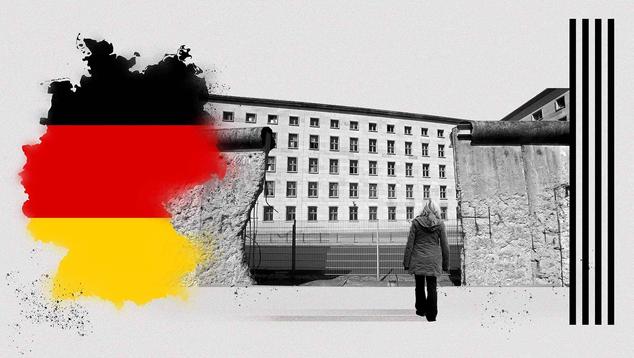LONDON -- Thirty-five years after the fall of the Berlin Wall, Gallup data show that people living in the former East and West Germany have more similarities than differences in how they view aspects of their lives.
This was not the case a decade and a half ago. Across 53 core indicators measured in Gallup’s annual public opinion polling in Germany between 2008-2010 and 2022-2024, 18 have converged (that is, the gap between the former East and West has shrunk by at least five percentage points).
Just six indicators have diverged, where East and West have grown more different, while 29 have stayed broadly stable.
Another way of analyzing the convergence in public opinion is to look at the average gap between East and West Germany across the same 53 indicators. In 2008-2010, this stood at 4.9 percentage points. It has since diminished by more than half and now stands at 2.2 points. This means fewer statistically significant differences in public opinion exist today (19 indicators) than in 2008-2010 (29 indicators).
Die Mauer im Kopf
The reunification of Germany in 1990 brought together the German Democratic Republic (East) and the Federal Republic of Germany (West) after more than four decades of division. East and West Germany had opposing political systems that resulted in two different societies.
The fall of the Berlin Wall in 1989 tore down a physical barrier but did not signal the end of all divides. Die Mauer im Kopf (the wall in the head) became a prominent catchphrase to describe the lingering differences -- cultural, political and psychological -- between East and West.
Many of these differences can still be observed today. The former East Germany has a smaller population, lower economic productivity and lower wages. Voting behaviors also differ, with the far-right Alternative fur Deutschland (AfD) seeing stronger electoral support in the East. Despite these demographic, economic and political differences, other historical divides have converged in recent years.
1. Religious Divides Are Starting to Disappear
Since reunification, the sharp religious divides that existed on either side of the wall have converged. Over time, the proportion of Christians has decreased in the West and increased in the East. The former remains more Christian than the latter, but to a smaller degree. A similar trend can be observed in the overall importance of religion, where religiosity remains higher in the West but is falling there, while increasing in the East.
2. Confidence in Institutions and Satisfaction With Services More Equal
Germans’ views of key institutions, such as the police, military and judiciary, have also changed considerably over time. From 2008-2010, those in the West had significantly more confidence in the police (+11 points), military (+12 points) and judicial system (+13 points) than those in the East. The gaps are now much narrower.
Before the wall fell, East Germany’s police and judicial systems were heavily influenced by the ruling communist party, as the Ministry for State Security (Stasi) exerted extensive control and surveillance over society.
Satisfaction with key services like education and healthcare have also converged. In the East, satisfaction with education has increased significantly, while satisfaction with healthcare and roads has decreased significantly in the West.
3. Former East Germany Grows More Generous With Money, Time, Strangers
Some of the indicators that have converged most sharply over time are proxy measures of “social capital,” which refer to levels of interpersonal trust within societies that help them function effectively. East and West Germany now look much more similar in terms of donating money, volunteering and helping strangers than they did from 2008-2010. In these three senses, civil society has strengthened considerably in the East in the past decade and a half.
4. Life Evaluations on Par
People in the former East and West Germany now evaluate their lives in similar ways. From 2008-2010, there was a significant gap in the percentage of people who could be classified as “thriving” in life, with 42% in the West thriving compared with 32% in the East. While the proportion of people who rate their lives positively enough to be considered thriving remains unchanged in the West (40% in 2022-2024), the East has caught up, with 41% in the region now thriving.
5. Some Indicators Buck the Trend
There are, however, a small number of indicators on which East and West have grown further apart. These include confidence in the honesty of elections and approval of U.S. leadership, which have increased considerably more in the West than the East.
For other indicators such as approval of European Union leadership, confidence in the national government and views of the condition of the local job market, the gaps between the regions have all remained stable over time. Much like from 2008-2010, people in the West continue to view these indicators more positively than those in the East.
Bottom Line
Three and a half decades on from the fall of the Berlin Wall, many real-world differences persist between the former East and West Germany, including population dynamics, income levels and voting behaviors.
Although these measurable differences exist, trends in public opinion between the two regions are converging considerably more than they are diverging. Many similarities in public opinion between East and West already existed when Gallup polled Germany between 2008 and 2010, almost 20 years after the fall of the Berlin Wall. Even more similarities exist today.
As Carsten Schneider, the commissioner for eastern Germany, explained last year: “Reunification is completed, even if it is not perfect.” The two regions look increasingly alike in how they view many spheres of life.
Die Mauer im Kopf -- the wall in the head -- that persisted long after 1989 looks like it, too, may be on the way down.
Analytical Note: Analyzing the extent of reunification in German public opinion requires a long-term view. Gallup has surveyed Germany -- including the former East and West German regions -- annually for almost two decades. Over that time, there have been annual fluctuations in opinion, which are magnified at the regional level when sample sizes become smaller.
As such, in this analysis, Gallup combined data from the three early years of polling Germany (2008, 2009, 2010), and the past three years (2022, 2023, 2024). Taking averages across those three-year periods -- themselves separated by more than a decade -- helps in evaluating longer-term societal shifts between the two regions.
The following regions were used for East and West Germany. East: Berlin, Brandenburg, Mecklenburg-Vorpommern, Sachsen, Sachsen-Anhalt, Thuringen. West: Schleswig-Holstein, Hamburg, Niedersachsen, Bremen, Nordrhein-Westfalen, Hessen, Rheinland-Pfalz, Baden-Wurttemberg, Bayern, Saarland.
Berlin was included as part of East Germany as an analytical decision. Repeating the analysis excluding Berlin yields similar results. Doing so, 19 indicators converge, 4 diverge and 30 are stable (compared with 18, 6, 29 including Berlin). The average gap between East and West excluding Berlin is 5.5% in 2008-2010 and 2.9% in 2022-2024 (compared with 4.9% and 2.2% including Berlin).
To stay up to date with the latest Gallup News insights and updates, follow us on X @Gallup.
For complete methodology and specific survey dates, please review Gallup's Country Data Set details.
Learn more about how the Gallup World Poll works.




